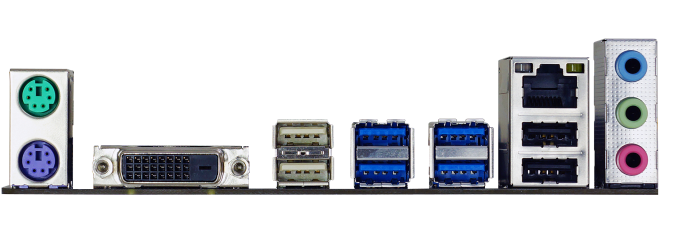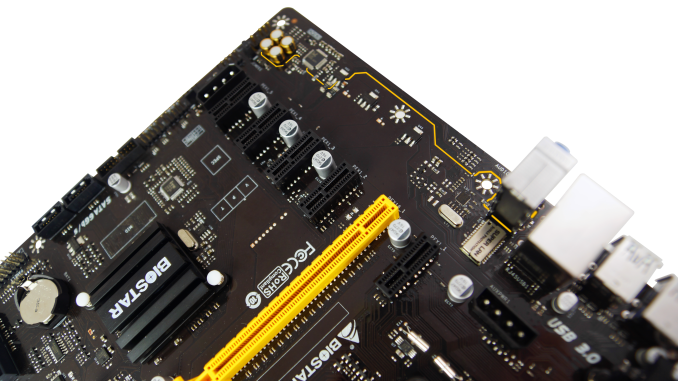BIOSTAR Reveals Two AMD AM4 Crypto Mining Motherboards
by Patrick MacMillan on May 10, 2017 1:00 PM EST
Although largely overshadowed by more efficient ASIC rigs, there are still people using GPUs to accumulate digital currencies and/or create cheap OpenCL based systems. It is with those users in mind that BIOSTAR has now expanded their lineup of specialized cryptocurrency mining motherboards to include two new AMD AM4 models.
Referred to as the TA320-BTC and TB350-BTC, these are the first AM4-based crypto mining motherboards announced, and as such make BIOSTAR the only manufacturer to offer mining motherboards for both mainstream platforms. This following the recent launch of Biostar's Intel LGA1151-based TB250-BTC model.
As you might have surmised, the TA320-BTC is based on the lower-end AMD A320 chipset, while the TB350-BTC is based on the mid-range AMD B350 chipset. After carefully scrutinizing the specifications list of both models, the only difference that we could find – chipset aside – is that the A320-based model is limited to memory speeds of DDR4-2666, while the B350 model supports up to DDR4-3200. These models only have two DDR4 memory slots each, so they are limited to 32GB of system memory.
Both motherboards support AMD's latest Ryzen processors (up to 95W TDP) and the upcoming 7th Generation A-Series APUs, which should be no problem for the 7-phase power design. Given their specialized purpose, these motherboards only have four SATA 6Gb/s ports and no M.2 slots. USB connectivity is quite decent with six USB 3.1 Gen1 ports (four rear, one header) and six USB 2.0 ports (four rear, one header). Two of the USB 2.0 ports are high amperage capable, so they can handle water pumps and/or fans that require up to 1.5 amps. Networking duties are handled by one gigabit LAN port that is powered by a Realtek RTL8111H controller. In terms of rear I/O connectivity, aside from the aforementioned ports, there are two legacy PS/2 connectors, a single DVI-D video output, and three audio jacks courtesy of a low-end Realtek ALC887 codec.
The key selling point of these two models is obviously their six PCIe slots. They each have one PCIe 3.0 x16 slot, two PCIe 3.0 x1 slots, and three PCIe 2.0 x1 slots. The PCIe x16 slot will operate at x8 if an APU is installed, due to AM4 APU limitations. Now you may be asking how PCIe x1 slots are useful when it comes to handling multiple graphics cards, and the answer is that miners use PCIe 1x to x16 riser cards with flexible extender cables (not included) and special cases that hold the graphics cards well above the motherboard. Crucially, there are also two 4-pin Molex power connectors intended to bolster power delivery to the PCIe slots, and they must be used when mining due to the increased power demands.
While full-size ATX motherboards generally measure 305mm × 244mm, these two models are both slightly shorter and narrower than the ATX standard at 295mm x 210mm. That may cause issues with certain cases, but BIOSTAR is likely betting on the fact that those who purchase these motherboards will be installing them on purpose-built open test benches.
We have no information with regard to pricing or availability, but both models will have a 3-year warranty in applicable regions. We expect the pricing to be quite low, given the margins that miners typically work with. Mining aside, any non-PCIe bandwidth limited task for compute, using OpenCL / CUDA and such could also be used.
Related Reading
Source: BIOSTAR





















22 Comments
View All Comments
fanofanand - Wednesday, May 10, 2017 - link
Do people still try to mine bitcoins? This product seems about 5 years too late.DanNeely - Wednesday, May 10, 2017 - link
AFAIK serious GPU mining is limited to various me-too coins that don't have ASIC miners available. (Yet!)JoeyJoJo123 - Wednesday, May 10, 2017 - link
Yeah, a dedicated ASIC designs are much more impactful than general purpose GPU or CPU mining.Also, kind of feel that that the whole crypto-currency thing has been a get-rich-quick meme that needs to die off already. Yeah, I understand that there are plenty of people that do make a quick buck on it, but the reality of the situation is that cryto-currency mining is such a saturated field that to get any crypto-currency at profitable rates (to not only pay off the capital or dedicated machine(s) designated to mining, but also the electricity costs incurred with the machine(s) and A/C costs) you need a pretty massive investment to "get rich quick" and you're still subject to the awfully variable values of the crypto-currency day-to-day.
Using crypto-currency as a pseudo-stock market is a bit better, because at least you're not dealing with the baggage of mining it yourself (where any crypto-currency worth its salt has such a high complexity for resolving chains that you'd need weeks to get 1 bitcoin, for example, or join a mining team where the bitcoin is shared amongst miners, but always in favor of the organizer of the mining team). But at the end of the day it's still such an absurd fluctuation where for every 1 person that "got rich quick" 5 others probably got real poor, real quick.
A sane and rational person wouldn't suggest crypto-currency mining to replace your day-to-day job. Might be OK as a side-hobby if you like doing this sort of stuff, but long gone are the days of "Hey you got a PC with a graphics card? Run this while you're not using your PC to get free money!"
boozed - Wednesday, May 10, 2017 - link
Also electricity thievesIan Cutress - Wednesday, May 10, 2017 - link
There's still a few *coins that work on CPUs. I know Patrick at ServeTheHome does some articles on Monero mining with CPUs as one of his burn-in tests for servers.Venya - Wednesday, May 10, 2017 - link
Ethereum (ETH) is the currently most profitable crypto-currency which can ONLY be mined using GPUs, because algorithm developed in such way that creating ASIC is not possible (or feasible)Skinandbones - Wednesday, May 10, 2017 - link
Z-cash, which was released October 28, 2016, is specifically designed against ASICS chips and favors AMD GPU cards. I don't understand how it all works, but the RX480 GPU was in hot demand by the farming community and has probably switched to the newer RX580. A quick search to get any one who is interested: http://cryptomining-blog.com/8349-claymores-zcash-...boozed - Wednesday, May 10, 2017 - link
Hahahaedzieba - Thursday, May 11, 2017 - link
Why on earth build a board designed to be overloaded with x16 cards, and not either use actual X16 physical slots (that are x1 electrically), or at the very least use x1 open-ended physical slots? While it satisfies the current x1-to-x16 riser situation, if they were to change (e.g. if a single-slot x16 card became the popular mining card) this board then becomes obsolete without modification.Manch - Thursday, May 11, 2017 - link
Purpose of the risers/cables is to keep the cards away from each other due to heat. I do wonder why they didn't include them though.